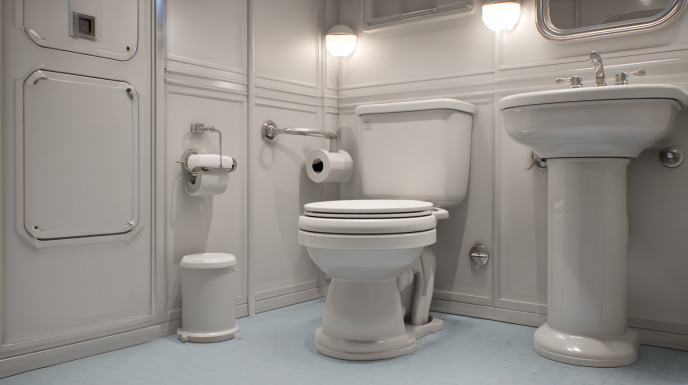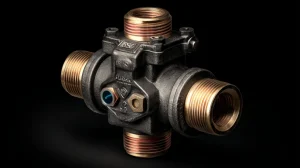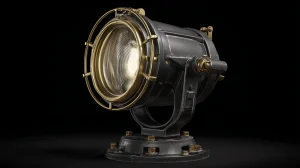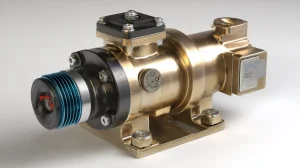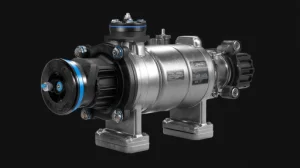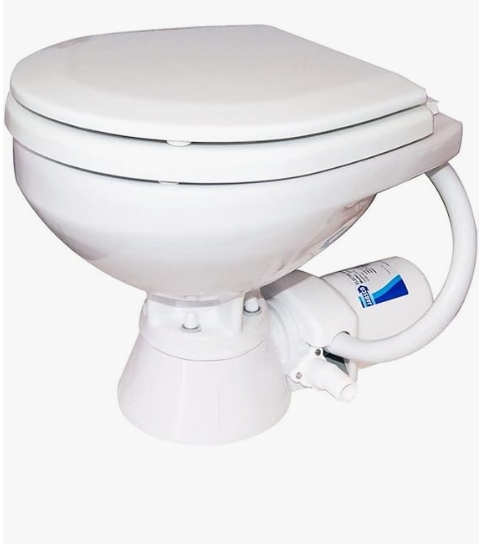
Jabsco 37010 Series, Electric Marine Toilet, Boating Head
- An Integral self-priming rinse pump designed to bring Sea, river or Lake water into the Bowl Comes standard
- A flexible design makes it suitable for overboard or holding Tank discharge
- A built-in backflow preventer Guards against flooding and waste return
- Corrosion-resistant materials throughout permit fresh or salt water service
- Can be mounted 3′ (1M) above or below the waterline with appropriate plumbing

Jabsco Lite Flush Compact Marine Electric Toilet with Foot Control
- Internally mounted, high speed, non-clogging, centrifugal, waste macerating pump driven by powerful 240 watt, 12 volt dc, permanent magnet motor with ball bearings and robust ceramic seal, discharges up to 5ft (1.5m) above the base of the toilet.
- Raw Water Rinse pump inlet – ¾” (19mm) hose tails. Flush pump discharge – 1½” (38mm) hose tail.
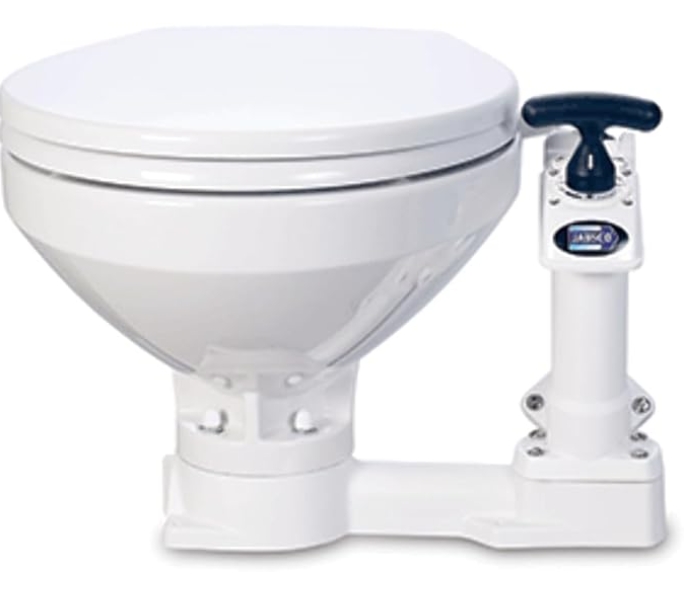
Jabsco Twist n’ Lock, Manual Marine Toilet Boating Head
- Powerful self-priming pump allows installation above or below the waterline
- Reversible mounting gives the option to install the pump on the right or left
- Flexible design makes it suitable for either overboard or holding tank discharge.
Understanding Your Onboard Sanitation System for Smoother Sailing
When you’re miles from shore with nothing but open water in every direction, certain comforts become more than luxuries—they become necessities. Among these, a reliable marine toilet system stands as perhaps the most essential onboard amenity for extended voyages. For decades, Jabsco has been the name countless boaters trust when nature calls at sea. But what exactly makes these marine sanitation devices so popular, and how can you ensure yours functions flawlessly through every nautical adventure?
Whether you’re a seasoned captain or a first-time boat owner, navigating the world of marine toilets can seem daunting. The good news? It doesn’t have to be. I’ve spent countless hours installing, maintaining, and yes, sometimes troubleshooting marine heads on vessels ranging from modest weekenders to luxury yachts. Today, I’m sharing everything I’ve learned about Jabsco marine toilets—from basic operation to advanced troubleshooting—to help you maintain this crucial piece of onboard equipment.
What Exactly Is a Jabsco Marine Toilet?
Jabsco marine toilets (often called “heads” in nautical parlance) are specialized sanitation fixtures designed specifically for use on boats and other marine vessels. Unlike your standard household toilet, these robust devices are engineered to operate in the challenging marine environment—handling motion, limited space, and water conservation requirements with remarkable efficiency.
The Jabsco brand, manufactured by Xylem Inc., has become nearly synonymous with marine toilets over the decades. Their reputation stems from creating durable, reliable units that can withstand the harsh conditions of marine environments while providing comfortable, home-like convenience. What separates these fixtures from your standard residential commode is their ingenious design that accounts for the unique challenges of maritime use.
These toilets come in various configurations, with the most common being the manual pump style and the electric flush model. Each design serves the same essential purpose but operates with different mechanisms and power requirements. What unites them is their specialized construction using marine-grade materials that resist corrosion from saltwater exposure and stand up to the constant movement and vibration inherent to sea travel.
When I installed my first Jabsco on a 32-foot cruiser, I was immediately struck by how much engineering had gone into something most landlubbers take for granted. The difference between a household toilet and a properly designed marine head becomes crystal clear the first time rough seas hit and everything in your boat is sliding—except your securely mounted Jabsco.
The Inner Workings: How Does a Jabsco Marine Toilet Operate?
Understanding how your marine toilet functions isn’t just interesting—it’s essential knowledge for any boat owner. The operating principle behind Jabsco toilets is both elegantly simple and remarkably effective.
Manual Models
The manual Jabsco operates through a hand-powered piston pump mechanism. When you move the handle, you create suction that draws seawater into the bowl for flushing and then pumps the waste into your holding tank or (where legally permitted) overboard. The process typically works in two stages:
- Pull the handle to bring water into the bowl for use or rinsing
- Push the handle to evacuate waste from the bowl
The beauty of this design is its self-sufficiency—no electricity required. This makes manual models perfect for smaller vessels or as backup systems on larger boats. The classic Jabsco Manual Marine Toilet has remained largely unchanged for years because, frankly, the design works exceptionally well.
Electric Models
Electric Jabsco toilets elevate the experience with push-button convenience. These units employ a macerator pump system that pulverizes waste before sending it to the holding tank, reducing clogs and allowing for smaller diameter discharge hoses. With the simple press of a button, the toilet automatically:
- Adds water to the bowl
- Activates the macerator to process waste
- Evacuates the contents to your holding tank
- Adds a final rinse to clean the bowl
During a recent refit of a 45-foot trawler, I replaced an aging manual head with Jabsco’s Deluxe Flush electric model. The owners later told me this single upgrade transformed their cruising experience more than any other improvement they’d made to the vessel. The convenience of electric operation makes boating life significantly more comfortable, especially for guests unfamiliar with manual marine toilets.
Both styles connect to a boat’s seawater intake system (or freshwater in some configurations) and discharge into a holding tank or, in some jurisdictions where permitted, directly overboard. The plumbing system typically includes anti-siphon loops and vents to prevent backflow—critical safety features that protect against the nightmare scenario of seawater siphoning back into your boat.
Why Choose a Jabsco? The Benefits Explained
The popularity of Jabsco marine toilets isn’t just market momentum—these units offer substantial advantages over both standard household fixtures and competing marine brands. Here’s why so many boaters make Jabsco their first choice:
Durability in Maritime Conditions
Marine environments are notoriously harsh on equipment. Salt, moisture, constant motion, and temperature fluctuations quickly destroy ordinary bathroom fixtures. Jabsco toilets are constructed with marine-grade materials specifically chosen to withstand these challenges. The porcelain bowls resist staining and scratching, while the pumping mechanisms use corrosion-resistant metals and heavy-duty plastics engineered for longevity.
I once salvaged a Jabsco manual toilet from a vessel that had been partially submerged during a hurricane. After a thorough cleaning and minor parts replacement, that toilet functioned perfectly for years afterward—testament to the exceptional build quality.
Space-Efficient Design
Boat designers know that every cubic inch counts on a vessel. Jabsco toilets feature compact footprints without sacrificing comfort or functionality. Their profile is typically lower than household toilets, with narrower tanks and intelligently positioned pump mechanisms that maximize space efficiency.
When retrofitting an older Catalina 30 with limited head compartment space, I found that the Jabsco compact model allowed for installation in an area where no standard household-style toilet could possibly fit—giving the owners a fully functional marine head where they previously had an uncomfortable portable toilet.
Water Conservation
Fresh water is precious on a boat. Jabsco toilets are designed to operate effectively with minimal water usage—typically less than a pint per flush for manual models and around 1-2 quarts for electric versions. Compare this to the 1.6 gallons (or more) used by standard household toilets, and the advantage becomes clear.
Versatility in Installation
Whether you’re working with a tiny weekender or a spacious yacht, Jabsco offers models suitable for various installation scenarios. Their toilets can be configured for above or below waterline mounting, with flexible options for intake and discharge routing.
Parts Availability
This might not seem important until you’re docked in a remote harbor with a malfunctioning head. Jabsco’s popularity means that replacement parts are widely available at marine supply stores worldwide. I’ve found essential Jabsco parts in tiny chandleries from the Caribbean to the Mediterranean—something that can’t be said for many competing brands.
Relative Affordability
While not the cheapest option available, Jabsco toilets offer excellent value considering their durability and performance. The initial investment typically pays dividends through years of reliable service and lower maintenance costs compared to budget alternatives.
Installation: Setting Up Your Jabsco Marine Toilet
Installing a marine toilet might seem intimidating, but with proper planning and the right approach, it’s a manageable project for a reasonably handy boat owner. That said, many choose professional installation to ensure compliance with marine sanitation regulations and proper integration with existing systems.
Pre-Installation Planning
Before picking up any tools, carefully consider:
- Location requirements: Sufficient space for the toilet and user comfort
- Through-hull fittings: Intake water source and discharge requirements
- Holding tank: Size, location, and connection points
- Ventilation: Essential for odor control
- Access: Ability to reach connections for maintenance
Basic Installation Steps
While specific instructions vary by model, the general process follows these steps:
- Mount the toilet base securely to the floor
- Use stainless steel fasteners appropriate for your deck material
- Ensure the mounting surface is reinforced if necessary
- Apply marine sealant to prevent water intrusion
- Connect the seawater intake
- Install a dedicated seacock and through-hull fitting if not already present
- Use marine-grade hose with double clamps at all connections
- Include a strainer to prevent debris from entering the pump
- Connect the discharge system
- Route sanitation hose to the holding tank with minimal bends
- Install vented loops above the waterline if necessary
- Ensure all connections are airtight to prevent odors
- For electric models, connect power
- Use marine-grade tinned wire of appropriate gauge
- Install a dedicated circuit breaker
- Ensure all electrical connections are sealed against moisture
- Test the system thoroughly
- Check for leaks at all connections
- Verify proper intake and discharge function
- For electric models, test all operating modes
During a recent installation on a 38-foot sailboat, I discovered the value of using high-quality sanitation hose rather than standard options. The premium hose was significantly more pliable, making the installation in tight quarters much easier, and its superior odor barrier properties justified the additional cost many times over.
Keeping It Clean: Maintenance Procedures
A clean, well-maintained marine toilet is a joy to use. Neglect it, and it quickly becomes the most dreaded feature of your boat. Fortunately, regular maintenance of a Jabsco marine toilet is straightforward and prevents most common problems before they start.
Daily Care
Simple daily habits make a tremendous difference:
- Flush thoroughly after each use
- Use marine toilet-specific cleaning products in the bowl
- Keep the bowl moderately filled with water when not in use (prevents seals from drying out)
- Never introduce foreign objects or standard household paper products
Weekly Maintenance
- Lubricate pump mechanisms with food-grade silicone spray
- Check hose connections for signs of leakage
- Inspect joker valve for proper operation (no backflow)
- Clean intake strainer if installed
Monthly Tasks
- Flush the entire system with a mild descaling solution
- Inspect all hoses for wear, chafing, or cracking
- Check mounting bolts for tightness
- Test vented loops and anti-siphon valves
Seasonal Maintenance
- Replace joker valve and seals annually
- Disassemble and clean pump assembly
- Inspect and clean check valves
- Verify holding tank monitor operation
- Check discharge macerator (on electric models)
During my years managing charter fleets, I developed a simple maintenance trick that saved countless service calls: keeping a spray bottle of vinegar-water solution near each marine toilet. A quick spray and wipe of the bowl and pump parts after each day’s use dramatically reduced calcium buildup and extended the life of seals and valves.
Troubleshooting Common Jabsco Marine Toilet Problems
Even with perfect maintenance, marine toilets occasionally develop issues. Knowing how to diagnose and fix common problems can save your voyage from an unpleasant interruption.
Problem: Difficult Pumping (Manual Models)
Potential Causes:
- Dried or damaged seals
- Mineral buildup in pump cylinder
- Blocked intake
- Clogged joker valve
Solutions:
- Lubricate seals with silicone grease
- Descale pump assembly with vinegar solution
- Clear intake strainer
- Replace joker valve if deformed or stiff
Problem: Weak Flush (Electric Models)
Potential Causes:
- Low voltage
- Worn macerator impeller
- Partial blockage
- Restricted discharge hose
Solutions:
- Check battery voltage under load
- Replace macerator assembly if worn
- Run descaling solution through system
- Inspect discharge hose for restrictions
Problem: Water Leaking Around Base
Potential Causes:
- Loose mounting bolts
- Damaged base seal
- Cracked porcelain
Solutions:
- Tighten mounting bolts evenly
- Replace base seal
- In case of cracked porcelain, replace toilet
Problem: Persistent Odors
Potential Causes:
- Permeated discharge hose
- Failed joker valve allowing backflow
- Inadequate ventilation
- Holding tank issues
Solutions:
- Replace old sanitation hose with premium odor-barrier type
- Install new joker valve
- Improve ventilation system
- Add holding tank treatment products
On a recent Caribbean charter, I encountered a Jabsco toilet that wouldn’t hold water in the bowl—a telltale sign of joker valve failure. With no replacement parts available locally, I fashioned a temporary repair using a piece of surgical glove (from the first aid kit) cut to match the valve shape. This improvised solution worked perfectly until we reached a port where proper parts were available. The lesson? Understanding how your marine toilet works can lead to creative solutions when you’re far from marine supply stores.
Parts Replacement: Extending Your Toilet’s Lifespan
One of Jabsco’s greatest advantages is the modular design that allows for easy parts replacement rather than complete toilet replacement. Most components can be serviced or replaced individually, often without removing the entire unit.
Commonly Replaced Parts
- Joker Valve: Perhaps the most frequently replaced part, this one-way valve prevents waste backflow. Replacement interval: annually or when showing signs of deformation.
- Pump Assembly Seals: These create the necessary vacuum for proper operation. Replacement interval: every 1-2 years depending on use.
- Discharge Macerator (electric models): The component that grinds waste before discharge. Replacement interval: 3-5 years or when performance diminishes.
- Handle Assembly (manual models): Subject to mechanical wear from regular use. Replacement interval: 3-5 years or when loose/difficult to operate.
- Bowl Gasket: Creates seal between porcelain bowl and base. Replacement interval: when leaks develop or during major service.
Replacement Tips
- Always purchase genuine Jabsco parts for proper fit and function
- Keep common wear items (joker valve, seals) as onboard spares
- Follow torque specifications carefully when reassembling
- Use food-grade silicone lubricant on O-rings and seals
- Test thoroughly after any parts replacement
After replacing a macerator assembly on a customer’s boat, I learned the value of proper break-in procedures. Running the new macerator briefly with clean water before normal use allowed the components to seat properly, extending its service life considerably compared to previous replacements.
Purchasing Guide: Finding the Right Jabsco Marine Toilet
Selecting the appropriate Jabsco model involves balancing several factors including your boat size, crew needs, power availability, and budget.
Where to Buy
Jabsco marine toilets are widely available through:
- Marine supply retailers (West Marine, Defender, etc.)
- Online marketplaces (Amazon, eBay)
- Specialty marine plumbing suppliers
- Boat equipment distributors
- Directly from some boatyards and marine service centers
I generally recommend purchasing from established marine retailers rather than general marketplaces, as marine specialists typically provide better support and often have service technicians familiar with installation requirements.
Price Ranges
Jabsco toilets span several price points depending on style and features:
- Manual Compact Models: $150-$300
Basic functionality in a space-efficient design - Standard Manual Models: $300-$500
Full-sized comfort with traditional pump action - Entry-Level Electric Models: $500-$700
Basic electric operation with standard features - Deluxe Electric Models: $700-$1,200
Premium features like multiple flush modes and household-style seats - Luxury Electric Models: $1,200-$2,000+
Top-of-line comfort with features like programmable flushing and porcelain bowls
Remember that installation materials (hoses, through-hulls, wiring) will add to these costs, often by $100-$300 depending on your specific setup requirements.
Popular Models Worth Considering
- Jabsco Manual Marine Toilet Regular Bowl: The classic workhorse that’s equipped countless vessels. Reliable manual operation with minimal maintenance needs.
- Jabsco Electric Marine Toilet with Compact Bowl: Perfect for smaller vessels wanting electric convenience without sacrificing space.
- Jabsco Deluxe Flush Electric Toilet: Offers multiple flush modes and premium comfort in a configuration familiar to landlubbers.
- Jabsco Quiet Flush Electric Toilet: As the name suggests, offers quieter operation—a significant benefit in vessels where the head compartment adjoins sleeping quarters.
When helping clients select marine toilets, I often recommend they physically try different models if possible. The height, seating comfort, and operational feel vary between models, and personal preference plays a significant role in satisfaction with your final choice.
Winterizing Your Jabsco Marine Toilet
For boaters in seasonal climates, proper winterization of marine systems is essential, and your toilet requires specific attention to prevent freeze damage.
The Winterization Process
- Empty the system completely
- Pump all water from the bowl and lines
- Ensure seawater intake line is drained
- Add non-toxic antifreeze
- Use only propylene glycol marine/RV antifreeze
- Never use automotive antifreeze (ethylene glycol)
- Pump antifreeze through entire system until visible in discharge
- Protect the bowl
- Add antifreeze to bowl to prevent trap freeze
- Consider removing water from the bowl entirely and adding mineral oil to seals
- Disconnect power (electric models)
- Turn off dedicated circuit breaker
- Consider disconnecting battery terminals
- Lubricate components
- Apply silicone grease to seals and moving parts
- Protect exposed metal with light coating of lubricant
For boats stored in heated environments, full winterization might not be necessary, but I still recommend running some antifreeze through the system as insurance against unexpected temperature drops or heating system failures.
Manual vs. Electric: Which Jabsco Is Right for You?
The manual-versus-electric decision represents one of the most significant choices when selecting a marine toilet. Each option has distinct advantages worth considering.
Manual Jabsco Advantages
- Reliability: With fewer components to fail, manual models offer legendary dependability
- Independence from electrical system: Functions even during power outages or battery conservation
- Simplicity: Easier to understand, troubleshoot, and repair
- Lower cost: Typically half the price of comparable electric models
- Reduced power consumption: Important for vessels with limited electrical capacity
Electric Jabsco Advantages
- Convenience: Push-button operation familiar to non-boaters
- Consistent performance: Maintains full flushing power regardless of user strength
- Superior maceration: Electric macerators typically handle waste more effectively
- Smaller diameter discharge hoses: Thanks to maceration capabilities
- Multiple flush options: Many models offer water-saving and full-flush modes
Making Your Decision
Consider these factors when choosing between manual and electric:
- Electrical capacity: Does your vessel have power to spare?
- User demographics: Will children or elderly persons use the toilet regularly?
- Redundancy needs: Some larger vessels install both types—electric for convenience, manual as backup
- Technical comfort: Are you comfortable troubleshooting electrical systems?
- Budget constraints: Not just for purchase, but maintenance as well
I’ve found that many first-time boat owners gravitate toward electric models for their familiarity, only to appreciate manual models later as they gain experience with marine systems. There’s no universal right answer—just the right choice for your specific needs.
Environmental Considerations
Modern boating increasingly emphasizes environmental responsibility, and your marine sanitation choices play a significant role in your vessel’s ecological impact.
Regulatory Compliance
Jabsco toilets can be configured to comply with various regulations, including:
- U.S. Coast Guard requirements for Marine Sanitation Devices (MSDs)
- International MARPOL standards
- Local discharge regulations in sensitive areas
The toilet itself is only one component of a compliant system—proper holding tanks, discharge controls, and sometimes treatment systems complete the package.
Environmental Benefits of Jabsco Systems
- Water conservation: Uses significantly less water than household toilets
- Sealed waste transport: Properly installed systems prevent waste from entering waterways
- Compatibility with treatment systems: Works with holding tank treatments that break down waste
- Durability: Longer lifespan means less manufacturing impact and waste
Responsible Operation
Even the best marine toilet requires responsible operation:
- Never discharge in prohibited areas
- Use biodegradable, marine-safe toilet paper
- Consider holding tank treatments that accelerate breakdown
- Maintain discharge components to prevent accidental leakage
- Use pump-out facilities whenever available
When I replaced the sanitation system on my own vessel, I opted for an oversized holding tank despite the space sacrifice. This choice has allowed extended cruising in environmentally sensitive areas without requiring frequent pump-outs or discharges—a small inconvenience that pays environmental dividends.
Alternatives to Jabsco: How They Compare
While Jabsco dominates the marine toilet market, several alternatives deserve consideration depending on your specific needs.
Dometic/SeaLand
Dometic (formerly SeaLand) offers premium marine toilets with some distinct advantages:
- Ceramic bowls in more models
- Generally quieter operation
- Often preferred in high-end yacht installations
- Higher initial cost but comparable longevity
Raritan
Raritan provides excellent alternatives with:
- Reputation for exceptional engineering
- Some unique features like freshwater flush systems
- Strong customer service
- Similar price range to comparable Jabsco models
Thetford
Known for portable toilets, Thetford also offers:
- Lower-cost permanent marine toilet options
- Simpler designs with fewer parts
- Less market presence means fewer available parts
- Good option for budget-conscious installations
Composting Toilets (Nature’s Head, Air Head)
These represent a fundamentally different approach:
- No water required for operation
- No discharge plumbing needed
- Environmentally friendly operation
- Higher initial cost but lower system complexity
- Requires different maintenance procedures
In comparing alternatives, I’ve found that Jabsco’s widespread adoption creates significant advantages in parts availability and service expertise that often outweigh minor feature differences. That said, some specialty applications may benefit from alternative manufacturers’ unique offerings.
Fixing a Leaking Jabsco Toilet
Few onboard problems create more immediate distress than a leaking toilet. Fortunately, most Jabsco leaks can be diagnosed and repaired relatively easily.
Common Leak Points and Solutions
- Base of toilet
- Likely cause: Loose mounting bolts or damaged base seal
- Solution: Tighten mounting bolts evenly or replace base seal
- Around pump handle
- Likely cause: Worn pump shaft seal
- Solution: Replace seal kit (inexpensive and straightforward)
- From bowl to base connection
- Likely cause: Damaged bowl gasket or loose connection
- Solution: Replace gasket and ensure proper assembly
- From hose connections
- Likely cause: Loose clamps or deteriorated hose
- Solution: Replace hose and use double clamps at each connection
- From discharge valve area
- Likely cause: Damaged joker valve or loose assembly
- Solution: Replace joker valve and ensure proper assembly
Emergency Leak Management
If a leak develops while underway, these temporary measures can help:
- Petroleum jelly can temporarily seal minor gasket leaks
- Rescue tape (self-fusing silicone tape) can provide emergency hose repairs
- Restricting water intake volume can reduce leak severity
- A catch basin placed under the leak point can contain water until repairs are possible
During an offshore passage, I once encountered a persistent leak from a pump assembly. Using a combination of temporary seal material (cut from a spare fender) and careful water management, we were able to maintain toilet function while limiting leakage until reaching port for proper repairs.
Toilet Paper Considerations
A seemingly minor detail—toilet paper selection—can have major consequences for your marine sanitation system’s health.
Can You Use Regular Toilet Paper?
The simple answer is no. Standard household toilet paper is designed to maintain strength when wet and often contains additives that resist breaking down—precisely the opposite of what you want in a marine system.
What To Use Instead
- Marine-specific toilet paper
- Designed to break down rapidly in marine systems
- Available at marine supply stores
- Typically more expensive but worth the investment
- RV toilet paper
- Similar rapid-dissolve properties to marine paper
- More widely available at camping stores
- Usually less expensive than marine-branded options
- Single-ply septic-safe paper
- Acceptable alternative in a pinch
- Still not ideal but better than standard options
- Widely available at most stores
The Paper Test
To test if toilet paper is suitable:
- Place a few sheets in a jar of water
- Shake vigorously for 30 seconds
- Let stand 10 minutes
- If paper hasn’t broken down into small pieces, it’s not suitable
After explaining this to countless boat owners, I’ve often heard the complaint that marine toilet paper isn’t as comfortable as premium household brands. My standard response: “Neither is paying for a macerator pump replacement or spending your vacation disassembling a clogged head.”
Accessories to Enhance Your Jabsco Experience
Several aftermarket accessories can improve functionality and user satisfaction with your Jabsco marine toilet.
Popular Add-ons
- Comfort Seats
- Household-style seats that fit marine toilets
- Provides familiar comfort and sometimes slow-close features
- Relatively simple retrofit
- Spray Rinse Kits
- Adds bidet-like functionality
- Improves bowl cleaning with less water usage
- Available in manual and electric versions
- Premium Control Panels (for electric models)
- Multi-function controls with water-saving options
- Status indicators for system operation
- Some offer programmable flush cycles
- Odor Control Systems
- In-line filters for vent lines
- Activated carbon systems
- Enzymatic tank treatments
- Holding Tank Monitors
- Provides accurate tank level readings
- Prevents surprise “full tank” situations
- Some offer remote monitoring via smartphone
One of the most appreciated upgrades I’ve installed on several boats is a premium soft-close seat with quick-release functionality. This seemingly small improvement dramatically increases user satisfaction and makes cleaning significantly easier—a perfect example of how the right accessory can enhance the marine toilet experience.
Longevity: How Long Will Your Jabsco Last?
One of the most common questions about marine toilets concerns their expected lifespan. While individual experiences vary based on usage patterns and maintenance, some general guidelines exist.
Typical Lifespan Expectations
- Manual Jabsco Toilets: With proper maintenance, 10-15 years of regular use is common, with many lasting 20+ years with periodic rebuilds
- Electric Jabsco Toilets: Typically 7-12 years before major components need replacement, though the porcelain and mounting hardware often last much longer
- Key Components: Expect to replace working parts like joker valves every 1-3 years, pump seals every 2-5 years, and macerators (on electric models) every 5-7 years
Factors Affecting Longevity
- Usage volume: Weekend-only use versus liveaboard use creates dramatic differences
- Maintenance frequency: Regular service significantly extends lifespan
- Water quality: Saltwater use creates more mineral buildup than freshwater
- User behavior: Proper use versus introducing inappropriate materials
- Installation quality: Proper initial setup prevents premature wear
I recently serviced a 22-year-old manual Jabsco that had been meticulously maintained throughout its life. Apart from routine replacements of consumable parts, the toilet functioned perfectly—a testament to both the quality of Jabsco products and the value of diligent maintenance.
Final Thoughts: Making Peace with Your Marine Toilet
After thousands of words about marine toilets, one truth remains: your relationship with your boat’s head system profoundly impacts your overall boating experience. Those who understand and properly maintain their marine toilets enjoy trouble-free voyaging, while those who neglect this critical system often find their journeys interrupted by unpleasant emergencies.
The Jabsco marine toilet, in whichever form you choose, represents decades of engineering refinement aimed at solving a fundamental human need in the challenging marine environment. Its popularity stems not from marketing but from genuine reliability when properly maintained.
Whether you’re selecting your first marine toilet or troubleshooting one you’ve had for years, I hope this guide provides the information you need to make informed decisions. The modest investment of time in understanding and maintaining your Jabsco will pay dividends through years of trouble-free service—allowing you to focus on enjoying your time on the water rather than addressing preventable problems.
Remember that even the best marine toilet requires respect for its limitations and regular attention to its needs. Treat your Jabsco well, and it will return the favor with years of reliable service in even the most challenging conditions.
Fair winds and trouble-free flushing on all your future voyages!

